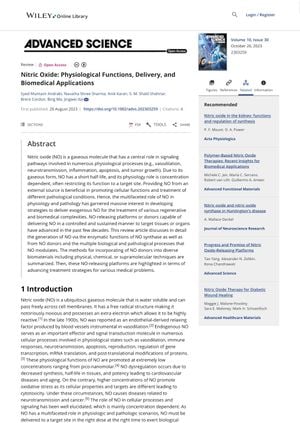Nitric Oxide: Physiological Functions, Delivery, and Biomedical Applications
August 2023
in “
Advanced Science
”

TLDR Nitric Oxide has potential in medicine, especially for infections and heart treatments, but its short life and delivery challenges limit its use.
Nitric Oxide (NO) plays a crucial role in various physiological processes such as vasodilation, neurotransmission, inflammation, apoptosis, and tumor growth. Its function is concentration-dependent and often restricted to a target site due to its short half-life. The document discusses the generation of NO via the enzymatic functions of NO synthase and from NO donors, and the various biological and pathological processes that NO modulates. It also summarizes the methods for incorporating NO donors into diverse biomaterials and highlights these NO-releasing platforms in terms of advancing treatment strategies for various medical problems. The document also discusses the various roles of NO in the body, including its role in the heart, nervous system, bone homeostasis, cancer, and reproduction. Despite its diverse physiological roles, the therapeutic applications of NO are limited due to its short half-life and insufficient concentrations available on-site. To overcome these challenges, strategies are being developed to create efficient NO-generating systems involving various types of NO-releasing carriers/donors. However, several obstacles still hinder the use of NO-based therapies in clinical settings, including concentration-dependent biological effects and the stability of NO donors/carriers under physiological conditions. The document concludes that NO has significant potential in biomedical applications, particularly in antimicrobial and cardiovascular treatments.







